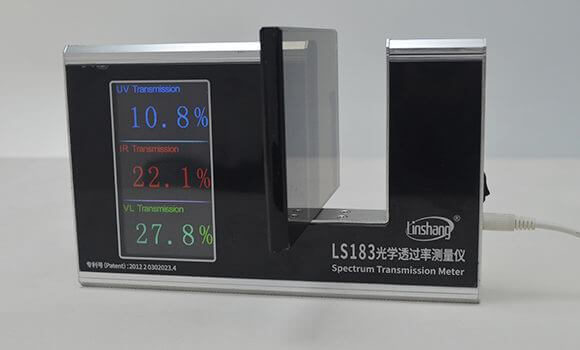Spectrum Transmission Meter Detect Glass
Automatic optical detection or optical metrology is now a very widely used field. With the continuous development of optical detection instruments, the spectrum transmission meter has become an important optical instrument. Such as Linshang LS183 spectrum transmission meter, LS108 blue-violet transmission meter, LS108A lens transmission meter, LS152 vacuum coating online thickness gauge, etc. Among them, the spectrum transmission meter plays an important role in the process of detecting glass.
How does the spectrum transmission meter play a role in the process of testing glass? There are two main aspects: the production of coated optical glass and glasses.
The spectrum transmission meter can affect the coating effect during the glass detection. For optical glass, the transmittance is not determined by the glass, but by the film coated on the glass. The designed film can increase the transmittance at a specific wavelength, or can reduce the transmittance at a specific wavelength. For uncoated glass, if organic and specific doped glass are not considered, the band gap of single crystal quartz is about 7eV, which is the largest band gap in common optical single crystal materials. Because the amorphous state will be smaller than the single crystal band gap, the absorption edge will be different according to the process. But unless a special process is used, the absorption edge of conventional glass is above 4eV, which means that there is almost no absorption of near ultraviolet but has certain absorption above the mid-ultraviolet band. Through the spectrum transmission meter, the actual transmittance of the coated optical glass can be detected to better meet the production process requirements and reduce the scrap ratio.
The spectrum transmission meter can affect the production of glasses during the process of detecting glass. For lenses, light transmittance generally refers to the visible light transmittance. Because after putting on the glasses, visible light needs to pass through the lens to enter the eyes and the things you see can be clearer. So for common people, the higher the visible light transmittance, the better. The first purpose of lens optical coating is to improve the light transmittance. The spectrum transmission meter can be used to detect the actual light transmittance of the lens. Through data comparison, the lens can be adjusted to a degree more suitable for human needs and enhance human comfort. This is an important role played by spectrum transmission meters in the manufacturing of eyeglasses. It is worth noting that in the manufacturing of glasses, some lenses are claimed to have anti-blue light function. The design requirement of the anti-blue light function is to filter out part of blue light, but blue light is visible light, so it will affect the visible light transmittanc. In the production process of anti-blue light glasses or other special glasses, pay special attention to the measured data of the spectrum transmission meter.
Linshang LS183 spectrum transmission meter has played an important role in detecting glass. Not only suitable for insulating glass and stick-film glass, LS183 spectrum transmission meter is also suitable for optical performance test of PMMA material, PC material,etc.
- Features of the LS183 UV Transmittance Meter
- Difference between Visible Light Transmission Meter LS183 and LS108H
- Spectacle lens anti-blue light detection---blue-violet light transmittance meter
- Spectrum Transmission Meter for Measuring PC Sheet
- Difference between LS103A and LS183 spectrum transmission meter
- Measuring the Transmittance of a Hemisphere by Plastic Transmittance Meter
